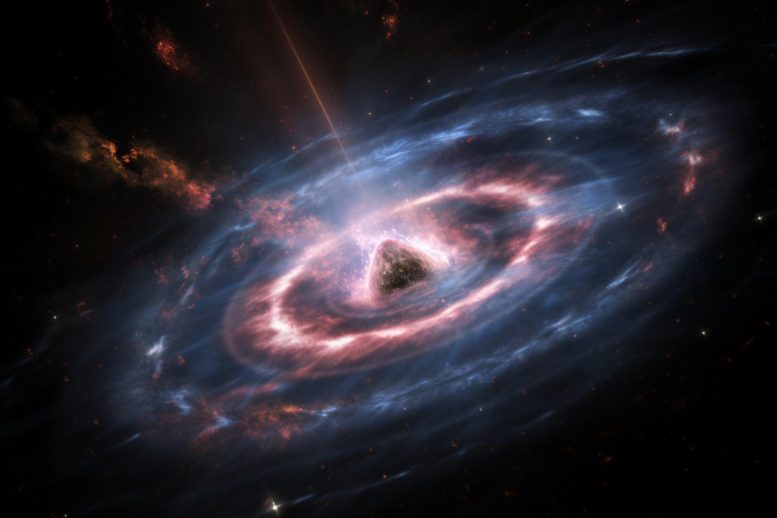
A University of Tokyo research team has discovered a consistent activation pattern of quasars throughout the universe’s history, influenced by surrounding dark matter halos. The study offers deeper insights into black hole formation, growth, and the broader evolution of the universe.
Dark matter turns supermassive black holes into energetic quasars consistently throughout history, with implications for the past evolution of the universe.
At the center of every galaxy is a supermassive black hole. Beyond a certain size, these become active, emitting huge amounts of radiation, and are then called quasars. It is thought these are activated by the presence of massive dark matter halos (DMH) surrounding the galaxy, directing matter toward the center, feeding the black hole.
A team of researchers including scientists from the University of Tokyo has, for the first time, surveyed hundreds of ancient quasars and found this behavior is very consistent throughout history. This is surprising, as many large-scale processes show variation throughout the life of the universe, so the mechanism of quasar activation could have implications for the evolution of the entire universe.
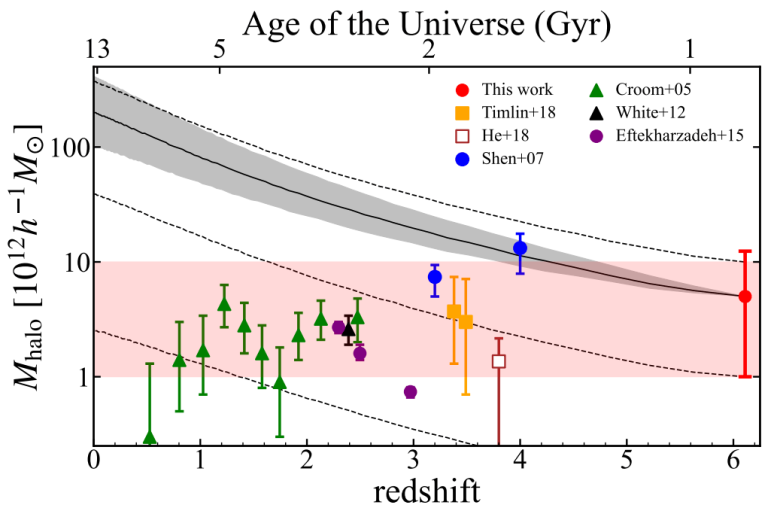
The vertical axis shows the mass of dark matter halos surrounding quasars, galaxies with active cores. The horizontal axis shows the age of the universe with the present on the left. Given so many properties of the universe change on these time scales, it’s surprising that the DMH mass corresponding to a quasar has remained stable. Credit: ©2023 Arita et al. CC-BY
Measuring Dark Matter Halos
Measuring the mass of DMHs is not easy; it’s famously a very elusive substance, if substance is even the right word to use, given the actual nature of dark matter is unknown. We only know it exists at all due to its gravitational impact on large structures such as galaxies. Thus, dark matter can only be measured by making observations about its gravitational effects on things. This includes the way it might pull on something or affect its movement, or through the lensing (bending of light) of objects behind a suspected area of dark matter.
The challenge becomes greater at large distances, given how weak the light from more distant, and therefore ancient, phenomena can be. But this did not stop Professor Nobunari Kashikawa from the Department of Astronomy, and his team, from trying to answer a long-standing question in astronomy: How are black holes born, and how do they grow?
The researchers are especially keen to explore this in relation to supermassive black holes, the largest kind, which exist in the heart of every galaxy. These would be very difficult to study were it not for the fact that some grow so massive they begin to output incredibly powerful jets of matter or spheres of radiation that in either case become what we call quasars. These are so powerful that even at large distances, we can now observe them using modern techniques.
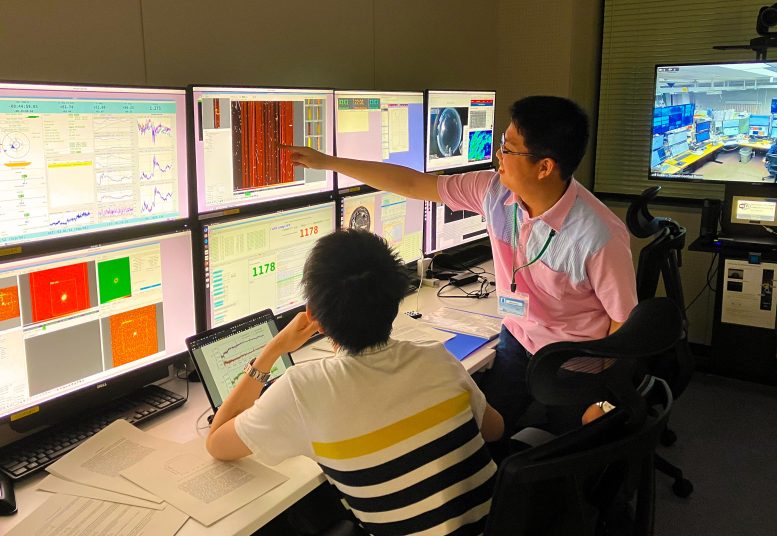
Principle investigator Junya Arita and co-investigator, Yoshihiro Takeda making observations in the control room of the National Astronomical Observatory of Japan. Credit: ©2023 Nobunari Kashikawa CC-BY
Findings and Implications
“We measured for the first time the typical mass for dark matter halos surrounding an active black hole in the universe about 13 billion years ago,” said Kashikawa. “We find the DMH mass of quasars is pretty constant at about 10 trillion times the mass of our sun. Such measurements have been made for more recent DMH around quasars, and those measurements are strikingly similar to what we see for more ancient quasars. This is interesting because it suggests there is a characteristic DMH mass which seems to activate a quasar, regardless of whether it happened billions of years ago or right now.”
Quasars at great distances appear faint, as the light that left them long ago has spread out, was absorbed by intervening matter, and has been stretched into nearly invisible infrared wavelengths due to the universe expanding over time. So Kashikawa and his team, whose project began in 2016, used multiple surveys of the sky which incorporated a range of different instruments, the main one being Japan’s Subaru Telescope, located in the U.S. state of Hawaii.
“Upgrades allowed Subaru to see farther than ever, but we can learn more by expanding observation projects internationally,” said Kashikawa. “The U.S.-based Vera C. Rubin Observatory and even the space-based Euclid satellite, launched by the EU this year, will scan a larger area of the sky and find more DMH around quasars. We can build a more complete picture of the relationship between galaxies and supermassive black holes. That might help inform our theories about how black holes form and grow.”
Reference: “Subaru High-z Exploration of Low-luminosity Quasars (SHELLQs). XVIII. The Dark Matter Halo Mass of Quasars at z ∼ 6” by Junya Arita, Nobunari Kashikawa, Yoshiki Matsuoka, Wanqiu He, Kei Ito, Yongming Liang, Rikako Ishimoto, Takehiro Yoshioka, Yoshihiro Takeda, Kazushi Iwasawa, Masafusa Onoue, Yoshiki Toba and Masatoshi Imanishi, 8 September 2023, The Astrophysical Journal.
DOI: 10.3847/1538-4357/ace43a
J.A. is supported by the International Graduate Program for Excellence in Earth-Space Science (IGPEES). N.K. was supported by the Japan Society for the Promotion of Science through Grant-in-Aid for Scientific Research 21H04490. Y.M. was supported by the Japan Society for the Promotion of Science KAKENHI grant No. JP17H04830 and No. 21H04494. K.I. acknowledges support by grant PID2019-105510GB-C33 funded by MCIN/AEI/10.13039/501100011033 and “Unit of excellence Mar´ıa de Maeztu 2020-2023” awarded to ICCUB (CEX2019-000918-M). M.O. is supported by the National Natural Science Foundation of China (12150410307).

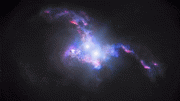
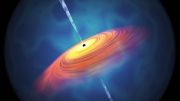

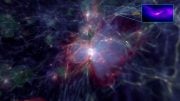



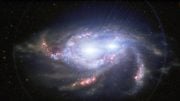
As though from science fiction; a big jump from 12 billion suns to one trillion suns; so just like a glutton, anything after a normal meal, is just regurgitation and hence the quasar.
Concentric dark matter halos is a new thing, no? So obvious. It will be interesting to watch relativity people continue the pretense that it’s not stationary rippling generated by angular moment conservation of in quantum gravity.
“angular moment conservation in quantum gravity”
Apparently a lot of people are going to try to visualize this as a periodic eruption of the galactic core, where all eruptions for some unexplained reason keep expanding as if core gravity does not exist. Looking at the most recent thin section images of dark matter (“Astronomers Observe Blobs of Dark Matter Down to a Scale of 30,000 Light-Years Across” where the only blobby thing is the spaces between the crossing ripples) shows concentric rings crossing, and the periodicity of spacing is notable except there are some period doubling features which seem at the moment most likely to be caused by shortcomings of the background data causing the microlensing algorithm to go a bit inconsistent in focus. I’ve been predicting a scale of around 100KLy and the fundamental spacing seems a decent match to the DM ripple scale reconstruction, where 30KLy seems to me likely to be the average distance between where the effect shown in orange is strongest and where it is weakest. I’ve also mentioned on this site before that the two possible variations of gravity quantization I’ve considered differ by a 2-to-1 ratio in wavelength.
“’Astronomers Observe Blobs of Dark Matter Down to a Scale of 30,000 Light-Years Across’ where the only blobby thing is the spaces between the crossing ripples”
Another headline confusedly referred to the same dark “blobs” (not the orange color where the dark matter is actually supposed to be, but the dark regions in between) as “clumps.” What I’m saying is multiple headline writers are pretending the regions lacking dark matter effects are the dark matter effect “clumps” (clumping parameters are fundamental for imagining exotic DM) and now they’re shading things towards “blobs” to buy more time for the experts to ignore ripples in the DM effect while they decide what to do next to politically-correctly pretend it’s not gravity that is the problem.
Could the physics of nature that is all of the universe change the titles of Black holes, Dark matter, Dark energy to a more suitable title considering the human understanding of their mechanisms. Referring to them in their original formations are becoming intensly different as observations have changed predictive conclusions. Black holes do not hold all matter they do burp after reaching a certain threshold.